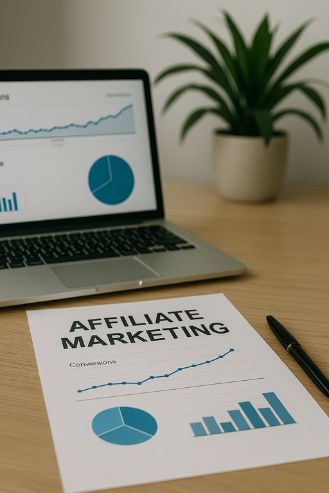
Native Ads Case Study: How an Affiliate Used Native Ads to Triple Conversions
This native ads case study breaks down how one affiliate tripled conversions in six weeks by combining disciplined testing, smart creative iteration, and relentless landing-page optimization. If you’re an affiliate wondering whether native can deliver dependable ROI beyond the occasional hit campaign, this deep dive will show the exact steps, mistakes avoided, and tactics that created durable gains rather than short-lived spikes.
Before launching, the affiliate set a clear financial target (profitable scale at a blended CPA under $18) and built a tight workflow: competitive research, creative angles, pre-sell page variations, tracking, and day-by-day optimization. For market reconnaissance and swipe files, the team paired internal research with competitive intelligence from tools like Anstrex Native Ads, which helped validate promising angles and publisher placements. The initial plan prioritized speed to first data, then structured iteration based on statistically meaningful signals instead of hunches.

The Starting Point and Baseline
At kickoff, the offer paid a $32 CPA with a broad consumer audience in Tier 1 geos. Historical data suggested native traffic could produce a strong EPC if the pre-sell content did real work: framing the problem, creating curiosity, and smoothing the transition to the sales page. Baseline performance from a tiny test budget ($150/day) yielded 0.6% CTR on headlines, a 9.8% landing-page click-through, and a painful $41 CPA—unprofitable, but useful for identifying leverage points.
The team hypothesized three leverage areas: (1) thumb-stopping creative that sparks curiosity without clickbait, (2) tighter pre-sell messaging matching the offer’s top three value props, and (3) stronger continuity between native widget, pre-sell, and final sales page. They also mapped a content sequence to warm up colder audiences with educational value, including how-to sections and contextual recommendations informed by cross-channel product recommendations best practices.
Campaign Architecture That Set Up the Win
Offer-Market Fit First
Instead of forcing an arbitrary product into native, they picked an offer with mass-market appeal and demonstrable outcomes. Criteria included: clear pain point, social proof available for the pre-sell, clean compliance history, and a sales page that loaded fast on mobile. They wrote angles around transformation (“before/after”), expert-backed tips, and relatable day-in-the-life vignettes, then aligned those angles to specific audience segments (new parents, time-strapped professionals, budget-conscious households).
Placement and Device Strategy
Mobile dominated, but tablets performed surprisingly well on weekends. The team whitelisted a small set of premium publishers at first to reduce noise, then slowly expanded. Early blocklists removed placements with bounce-heavy traffic. They also split campaigns by device to tune bids independently, noticing that Android CTR led the way but iOS converted better after pre-sell adjustments—evidence that creatives and pre-sell alignment matter more than raw CTR.
Creative and Pre-Sell Framework
The creative framework used four angles—Curiosity, Authority, Empathy, and Proof. Each angle had 5–7 headline variants and 2–3 images, including lifestyle shots and simple illustrations. Pre-sell pages mirrored the angle: Authority pages led with expert quotes and data; Empathy pages opened with a mini-story; Proof pages showcased step-by-step outcomes. The result was a test matrix that could be pruned quickly once early winners emerged.
Data-Driven Testing Without Burning Budget
The team ran structured sprints: 72 hours per wave with caps to prevent runaway spend. They used simple rules: promote creatives that beat control CTR by 25%+, pause those 20% below average after 1,000 impressions, and only scale landing pages that improve click-to-offer by 15%+ at 95% confidence. A basic sequential testing approach sufficed; no exotic statistics, just clean naming conventions and enough data per cell to avoid false positives.
Key metrics on a single dashboard kept everyone aligned: CTR (widget), LP CTR (pre-sell to offer), CVR (offer), CPA (blended), and EPC by placement. They normalized for placement quality and monitored dayparting effects—weekday mornings beat nights by a wide margin for this offer. Importantly, they judged creatives by downstream revenue, not vanity CTR; one “viral” headline was paused because it filled the funnel with low-intent clicks that didn’t buy.
Bid strategy began conservative, then ratcheted up on proven pockets. They used tiered rules: nudge bids +10% on placements with CPA under target for 48 hours; pull back -10% on those 10–20% above target; pause anything worse than 20% above target after 300 clicks. Frequency capping on daily counts limited ad fatigue, while creative refreshes every 5–7 days kept performance stable across longer flights.
Optimizations That Moved the Needle
Pre-Sell Copy and Structure
They trimmed intro fluff and led with a sharp promise, then “laddered the logic”: problem framing, research-backed insight, social proof, and a simple call to action. Two changes made the biggest impact: adding scannable subheadings every 2–3 paragraphs and placing the first CTA button above the fold while repeating it at natural breakpoints. Heatmaps showed readers lingered on comparison tables and user stories—both stayed.
Page Speed and Mobile UX
Native users bounce fast when pages feel heavy. The team compressed images, deferred non-critical scripts, and simplified CSS. Largest Contentful Paint dropped from 3.9s to 1.8s on 4G, and CLS issues disappeared after tightening image dimensions. They also increased tap target sizes and used a sticky “Continue” button on long-form pre-sells, which boosted LP CTR by 19% on mobile.
Message Continuity
Top-performing headlines and hero images were mirrored on the pre-sell and echoed on the sales page to reduce cognitive dissonance. They swapped generic “Learn More” CTAs for specific micro-promises (e.g., “See the 3-step routine”), which signaled continuity and set expectations. This small copy shift improved offer CVR without changing the offer page.
The Results: From Red to Remarkably Profitable
By week two, they had a clear winner: an Empathy-led angle with a lifestyle image and a headline phrased as a question. CTR rose to 1.4%, LP CTR to 18.7%, and CPA fell to $24—still above goal but moving the right direction. After landing-page refinements and tighter message continuity, week four hit a blended CPA of $17.20 with conversions up 3.1× compared to the baseline. Importantly, quality held; refund rates and chargebacks stayed flat, and average order value ticked up due to stronger framing of bundles on the offer page.
At scale (roughly $1,800/day), ROAS stabilized at 1.87 with pockets above 2.1 on premium placements. The team continued to rotate creatives weekly and archived underperformers to maintain freshness. Because the system emphasized transferable principles—angle discipline, continuity, and measured iteration—the results persisted even as competition thickened and CPMs rose slightly.
Avoiding Common Pitfalls
Three mistakes almost derailed early momentum. First, chasing CTR without watching EPC created a few expensive rabbit holes; they fixed this by weighting decisions on revenue per 1,000 impressions. Second, testing too many variables at once made attribution muddy; moving to a weekly test theme (creative first, LP second, placements third) restored clarity. Third, failing to set guardrails on new placements led to a brief margin dip; adding conservative caps and staged rollouts prevented repeats.
Tools, Process, and Governance
Success here wasn’t about a single “secret trick,” but about a repeatable process: research → angle hypotheses → minimal viable test → prune → deepen winners → scale. Competitive intelligence solutions like Anstrex informed the angle shortlist; simple dashboards condensed the signal; checklists ensured nothing was missed in the rush to launch. The team also adopted a lightweight pre-flight compliance check to avoid sudden disapprovals from creative or copy choices that strayed too close to prohibited claims.
Scaling Without Burning Out the Audience
Horizontal scaling beat pure bid inflation. They expanded into adjacent audiences that shared the same core pain point, then refreshed creatives to match the segment language and visuals. Whitelisting high-EPC placements allowed larger daily caps while keeping CPA in range. Dynamic budgets reallocated spend every morning based on rolling 3-day performance, smoothing volatility when a creative fatigued faster than expected.
Ethical, Brand-Safe Execution
Native advertising can be powerful, but trust is fragile. The best performers in this case study avoided exaggerated claims, used clear disclosures on pre-sell pages, and honored the reader’s time with genuinely useful information. That approach didn’t just protect the account—it improved conversion quality by aligning expectations before the click to the offer page.
Conclusion
Tripling conversions with native isn’t magic—it’s the compound effect of tight angle discipline, message continuity, and a testing cadence that favors clarity over chaos. Start with a realistic CPA target, move quickly to first signal, and let the numbers—not ego—decide the winners. If you later branch into adjacent channels, review common push ad mistakes to keep your playbook sharp across formats. With a strong pre-sell, honest copy, and a simple measurement stack, native can become one of the most reliable profit centers in your affiliate portfolio.


